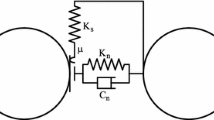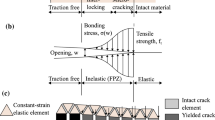Abstract
The softening function is the main input needed to model the fracture of concrete when using a cohesive crack approach. The simplest softening function that describes concrete behaviour reasonably well is a bilinear one. It is defined by four parameters: the tensile strength ft, the specific fracture energyG F, and two parameters characterizing the shape of this function. Here it is shown how these parameters can be derived from experimental measurements on notched beam tests. In particular, the parameters characterizing the shape of the function come from knowledge of the tail of the load-displacement curve and from the recorded maximum loads when similar beams of different sizes are tested.
Resume
La modélisation des fissures dans le béton par des fissures cohésives s'est avérée être un procédé très utile. Une des composantes de base du modèle est la courbe d'amollissement. Il est bien connu que la forme de cette fonction a une influence déterminante sur la réponse structurelle, en particulier sur la courbe force-déplacement.
Cet article prèsente une nouvelle méthode d'identification des propriétés essentielles de la courbe d'amollissement à partir d'essais sur des poutres entaillées. Une courbe d'amollissement quelconque dépendant de quatre paramètres peut être envisagée; mais l'article est centré sur une relation bilinéaire à quatre degrés de liberté. On montre que quatre paramètres géométriques essentiels de la courbe peuvent être facilement estimés à partir d'essais classiques (les essais ASTM de module élastique et de traction indirecte-brésilien-et la recommandation de la RILEM pour la mesure de l'énergie de fracture par la méthode du travail de fracture).
On applique la méthode pour déterminer ces parmètres à des résultats d'essais faits au préalable par les auteurs, et on compare les résultats obtenus pour la courbe d'amollissement GBF (de l'anglais ‘general bilinear fit’) avec d'autres approximations bilinéaires que l'on trouve dans la littérature. La différence la plus importante est que l'identification GBF montre une extrémité beaucoup plus longue que le reste des approximations. Le résultat essentiel est que toutes les approximations donent une bonne prédiction de la courbe force-déplacement dans la région proche du pic de charge, mais seule l'approximation bilinéaire à longue extrémité (GBF) donne aussi une excellente prédiction des régions post-pic et post-pic lointaine.
Similar content being viewed by others
References
Hillerborg, A., Modéer, M. and Petersson, P. E., ‘Analysis of crack formation and crack growth in concrete by means of fracture mechanics and finite elements’,Cem. Concr. Res. 6 (1976) 773–782.
RILEM 50-FMC Recommendation, ‘Determination of fracture energy of mortar and concrete by means of three-point bend test on notched beams’,Mater. Struct. 18 (1985) 285–290.
Hillerborg, A., ‘Results of three comparative test series for determining the fracture energyG F of concrete’, —Ibid.,18 (1985) 407–413.
Guinea, G. V., Planas, J. and Elices, M., ‘Measurement of the fracture energy using three-point bend tests: 2. Influence of experimental procedures’, —ibid.25 (1992) 212–218.
Planas, J., Elices, M. and Guinea, G. V., ‘Measurement of the fracture energy using three-point bend tests: 2. Influence of bulk energy dissipation’, —ibid.25 (1992) 305–312.
Elices, M., Guinea, G. V. and Planas, J., ‘Measurement of the fracture energy using three-point bend tests: 3. Influence of cutting theP-δ tail’, —ibid.25 (1992) 327–334.
Reinhardt, H. W., Cornelissen, H. A. W. and Hordijk, D. A., ‘Tensile tests and failure analysis of concrete’,J. Struct. Engng ASCE 112(11) (1986) 2462–2477.
van Mier, J. G. M., ‘Fracture of concrete under complex stress’,Heron 31(3) (1986) 2–90.
Wittmann, F. H., Rokugo, K., Bruhwiler, E., Mihashi, H. and Simoni, P., ‘Fracture energy and strain softening of concrete as determined by means of compact tension specimens’,Mater. Struct. 21 (1988) 21–32.
Wittmann, F. H., Roelfstra, P. E., Mihashi, H., Huang, Y. Y., Zhang, X. H. and Nomura, N., ‘Influence of age of loading, water-cement ratio, and rate of loading on fracture energy of concrete’, —ibid.20 (1987) 103–110.
Maturana, P., Planas, J. and Elices, M., ‘Evolution of fracture behaviour of saturated concrete in the low temperature range’,Engng Fract. Mech. 35 (1990) 827–834.
Dutron, P., ‘Mise au point, d'une composition de béton de référence pour recherches et essais en laboratoire’,Mater. Struct. 7 (1974) 207–224.
Petersson, P. E., ‘Crack growth and development of fracture zone in plain concrete and similar materials’, Report TVBM-1006 (Division of Building Materials, Lund Institute of Technology, 1981).
Planas, J. and Elices, M., ‘Size effect in concrete structures: Mathematical approximations and experimental validations’, in ‘Cracking and Damage, Strian Localization and Size Effect’, edited by J. Mazars and Z. P. Bazant (Elsevier, 1988) pp. 462–476.
—Idem.,, ‘Nonlinear fracture of cohesive materials’,Int. J. Fract. 51 (1991) 139–157.
Rokugo, K., Iwasa, M., Suzuki, T. and Koyanagi, W., ‘Testing methods to determine tensile strain softening curve and fracture energy of concrete’, in Proceedings of International Workshop on Fracture Toughness and Fracture Energy—Test Methods for Concrete and Rock, Sendai, 1988.
van Mier, J. G. M., ‘Scaling in tensile and compresive fracture of concrete’, in ‘Applications of Fracture Mechanics to Reinforced Concrete’, edited by A. Carpinteri (Elsevier, 1992), pp. 95–135.
Liaw, B. M., Jeang, F. L., Du, J. J., Hawkins, N. M. and Kobayashi, A., ‘Improved non linear model for concrete fracture’,J. Engng Mech. ASCE 16 (1990) 429–445.
Hasegawa, T., Shioy, T. and Okada, T., ‘Size effect on splitting tensile strength of concrete’, in Proceedings of Japan Concrete Institute 7th Conference (Japan Concrete Institute, 1985), pp. 309–312.
Bazant, Z. P., Kazemi, M. T., Hasegawa, T. and Mazars, J., ‘Size effect in Brazillian split-cylinder tests: Measurements and fracture analysis’,ACI Mater. J. 88(3) (1991) 325–332.
Tang, T., Shah, S. P., and Ouyang, C., ‘Fracture mechanics and size effect of concrete in tension’,J. Struct. Engng ASCE 118(11) (1992) 3169–3185.
Modéer, M., ‘A fracture mechanics approach to the failure analysis of concrete materials’, Report TVBM-1001 (Division of Building Materials, Lund Institute of Technology, 1979).
Jenq, Y. S. and Shah, S. P., ‘A two parameter fracture model for concrete’,J. Engng Mech. ASCE 111(10), (1985) 1227–1241.
Mihashi, H., ‘Material structure and tension softening properties of concrete’, in ‘Fracture Mechanics of Concrete Structures’, edited by Z. P. Bazant (Elsevier, 1992) pp. 239–250.
Author information
Authors and Affiliations
Rights and permissions
About this article
Cite this article
Guinea, G.V., Planas, J. & Elices, M. A general bilinear fit for the softening curve of concrete. Materials and Structures 27, 99–105 (1994). https://doi.org/10.1007/BF02472827
Issue Date:
DOI: https://doi.org/10.1007/BF02472827




